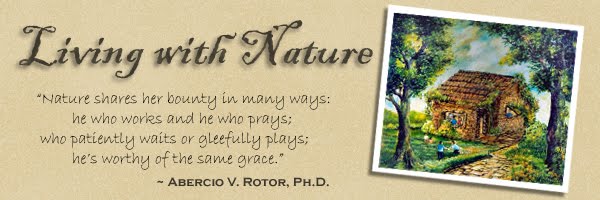Trees are Benevolent Hosts
Dr Abe V Rotor
 Playing hide-and-seek in a bamboo grove. The
Playing hide-and-seek in a bamboo grove. The spirit of the place gives quaintness to living.
Taal, Batangas
 Phylodendron gains foothold on Dita tree (Alstonia
Phylodendron gains foothold on Dita tree (Alstonia scholaris) as it reaches for the sun several meters high.
UST Botanical Garden
 Algae and mosses live on the spongy bark of acacia,
Algae and mosses live on the spongy bark of acacia,providing nutrients to the tree, and creating a
favorable microclimate. UP Diliman, QC
 Balete (Ficus benjamina) strangles emergent tree
Balete (Ficus benjamina) strangles emergent treewith interlacing roots and branches locking its host
to certain death, hence gaining a notorious name of
Strangler's Fig. Mt Makiling, Laguna
 Roots are exposed by slow erosion reveal tenacity
Roots are exposed by slow erosion reveal tenacity of this tree. The tree allows growth of plants and
animals like millipede and land snails, as well as
micrororganims, many are symbionts to the tree.
Mt Makiling Botanical Garden, UPLB
 Interlacing roots, principle of inarching, riprap
Interlacing roots, principle of inarching, riprap slopes and banks, provide abode to many organisms.
Mt Makiling, Laguna.
 Fruticose lichen clings on bark of tree. Lichens are
Fruticose lichen clings on bark of tree. Lichens are communities of algae and fungi. They aid in food
production and recycling of organic matter, as well
as help conserve water. Caliraya Lake, Laguna
 Crustose lichen coats trunk of young tree. Lichens are
Crustose lichen coats trunk of young tree. Lichens areimportant to the tree; they also indicate pristine
condition of the environment. Caliraya Lake, Laguna
 Drynaria fern as ephipyte helps conserve water, attract
Drynaria fern as ephipyte helps conserve water, attract wildlife that protects trees from pests and diseases.
It is not unusual that a branch gives way to the weight
of the tenant fern. St. Agustin Parish, Tagudin, Ilocos Sur
 Even after death the tree remains a host to red
Even after death the tree remains a host to redmushroom, termites, other saprophytes and
decomposers, giving off its entire energy to
serve the living world.



No comments:
Post a Comment